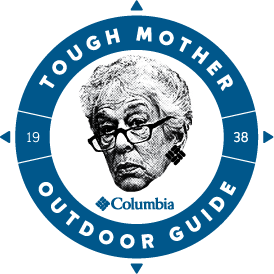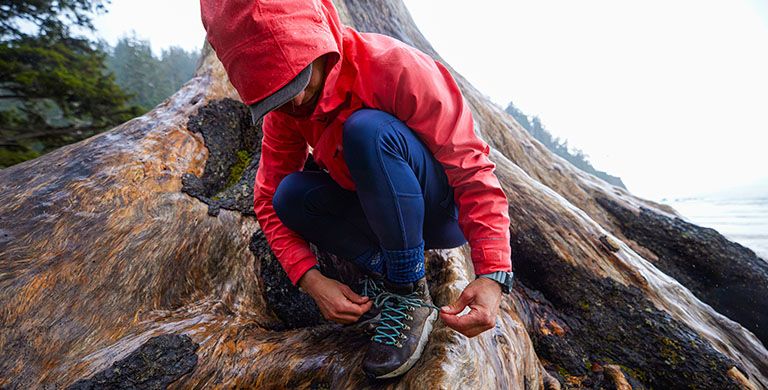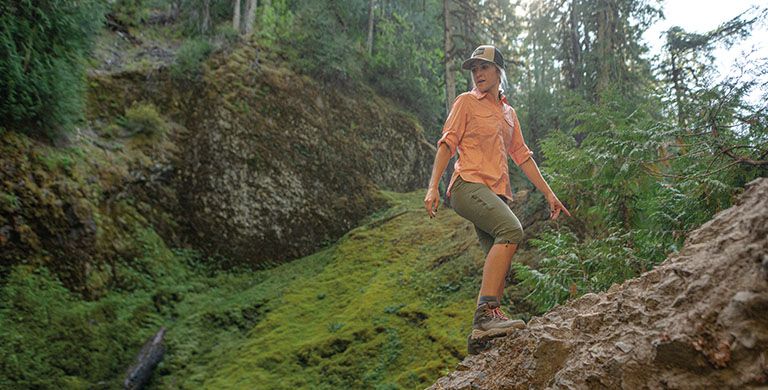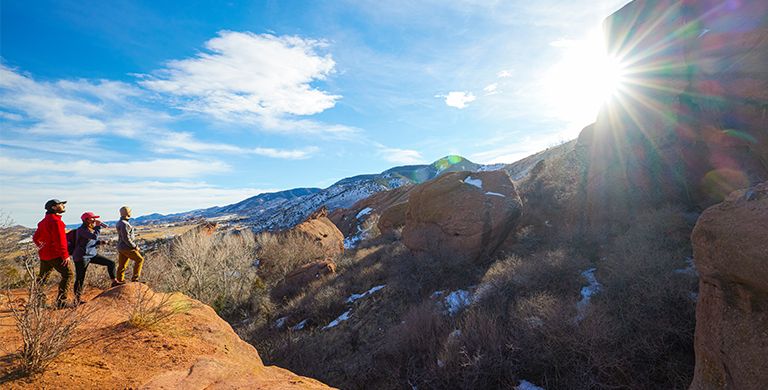
HIKING
A Beginner’s Guide to Backpacking
Everything you need to know for how to start backpacking
BY TROY ASPLUND
There’s no purer form of getting back to nature than backpacking. Surviving on only what you can carry in your backpack often for days at a time, is a true test of self-sufficiency. But how does one go from car camper and recreational hiker to full-on backpacker?
From how to get started to everything you’ll need for a successful first backpacking journey, we’ll take you through all the basics of planning backpacking trips for beginners, and give you some backpacking tips and tricks. We’ll also provide you with some destinations around the world to put on your backpacking bucket list
From how to get started to everything you’ll need for a successful first backpacking journey, we’ll take you through all the basics of planning backpacking trips for beginners, and give you some backpacking tips and tricks. We’ll also provide you with some destinations around the world to put on your backpacking bucket list

What is backpacking?
Backpacking is essentially any hiking trip where you carry your gear on your back and camp on the trail overnight. Trips can range from a quick overnight stay to multiday treks that can last up to a week or more.
It is camping with no campground in sight and your car likely miles, sometimes even days, back. It definitely isn’t car camping. Everything you need, from what you wear to what you eat to where you sleep, must be carried on your back. Backpacking is trading life’s creature comforts for the unmatched beauty of remote mountains, dense forests, and unspoiled wilderness areas that few get to see.
It’s a great opportunity to improve upon your regular hiking skills (referred to simply as “day hiking”).
Some diehards will even backpack long trails for weeks or months at a time, although this is often referred to as thru-hiking (In those, you complete an entire trail over an extended period of time, dropping supplies at key destinations or stopping to refuel at towns along the way).
It is camping with no campground in sight and your car likely miles, sometimes even days, back. It definitely isn’t car camping. Everything you need, from what you wear to what you eat to where you sleep, must be carried on your back. Backpacking is trading life’s creature comforts for the unmatched beauty of remote mountains, dense forests, and unspoiled wilderness areas that few get to see.
It’s a great opportunity to improve upon your regular hiking skills (referred to simply as “day hiking”).
Some diehards will even backpack long trails for weeks or months at a time, although this is often referred to as thru-hiking (In those, you complete an entire trail over an extended period of time, dropping supplies at key destinations or stopping to refuel at towns along the way).
Planning your first backpacking trip
While the idea of setting off on your first backpacking trip can be exciting, you want to make sure you don’t get ahead of yourself. Proper planning is the key to a successful and enjoyable journey—on your first trip and every trip after. Here are some key things to keep in mind as you get ready to head off into the great outdoors.
Plan your route
Choose a trail and trip length that is appropriate for your skill level. Note key landmarks, water sources, and potential camping spots.
Research the area
Know if there are any special permit requirements. Be aware of any fire dangers or campfire restrictions. Check for potential hazards or trail closures. Know what wildlife you’re likely to come across and plan accordingly (e.g., bear mace, bear cans, or odor-proof bags to protect food).
Check the weather
While you should always be prepared for most any weather condition, knowing the expected forecast can help you make some packing decisions. For example, in colder temperatures, you might bring an additional fleece, while in warmer weather, you might opt for a lighter-weight sleeping bag. It’s also important to check for the potential of extreme weather events, like heavy rain or lightning, that can create dangerous situations. In those cases, it’s often safest to delay your trip.
Learn basic wilderness survival skills
Be sure you have the basic know-how to help you survive out in the wilderness: navigation skills (how to read a map and use a compass), starting a fire, filtering water, preparing food, setting up and breaking down your camp, and basic first aid.
Listen to the experts
You don’t have to learn everything all on your own. Take a class or guided backpacking trip. Ask experienced backpackers for their advice—especially ones who have traversed your planned route. There are also plenty of videos, blogs, and websites where you can find additional tips and advice from backpackers.
Start with a shorter trip
Make sure your first time out isn’t a multiday, 75-mile mountainous trek. So what is a good distance for a beginner backpacking trip? We’d suggest an overnight trip of nothing more than 10 miles total—that’s 5 miles in and 5 miles back out. And if that first trip has a lot of elevation gain, you might want to make it even shorter.
Test your gear
Miles from nowhere is no time to find out your water filter is clogged and not working. So make sure to test everything before your trip—test your water filtration, your camp stove, your tent, etc. It’s also hugely important that you break in your hiking boots
before you go. Stiff boots make for blisters, and blisters make for total misery.
Plan your meals
Food can quickly weigh down your pack, so it’s important to be creative when it comes to backpacking meal ideas. Save weight by avoiding any canned or jarred foods, and choose dehydrated foods and packaged camp meals instead. Keep in mind that you can burn 5,000 calories or more per day, so choose energy-boosting foods with fats and carbohydrates—the trail is no place for dieting.
Share your route/plan
Before setting out, make sure someone you trust knows your intended route so that rescuers can more easily find you should you run into any sort of trouble. Be sure to share all of the following:
- When and where you’re going
- When you plan to return
- The vehicle you’re driving to the trailhead
- Planned route and daily distance goals
- Specific details like backpack or jacket colors, etc.

What to bring: a backpacking gear checklist
Once your trip is planned, it’s time to pack up and head out. The first thing you’ll need is, of course, a backpacking backpack. It should be big enough to hold everything you’ll need. Keep in mind that one of the biggest mistakes of beginner backpackers is overloading their pack and making it too heavy. So it’s important to stick to these backpacking essentials and look to cut weight wherever possible. In addition to choosing ultralight backpacking accessories, another way to limit your pack weight is to spread the load across your backpacking party—one person carries the tent, another person carries the cook stove, for example.
Clothing
What to wear backpacking is very similar to what you wear hiking. The main difference is that you’ll need a few changes of some of that clothing, depending on the length of your trip. But with limited pack space, you need every piece of clothing to count, which is exactly what layering is designed to do. One of the keys to layering is choosing things you can easily get on and off so you can quickly adapt to the conditions and your activity level.
The three-layer rule of layering applies to any season, though warmth, thickness, and clothing technologies can vary. The three layers are:
The three-layer rule of layering applies to any season, though warmth, thickness, and clothing technologies can vary. The three layers are:
- Baselayer – A good backpacking baselayer is a thin layer worn closest to your body, so it’s able to wick sweat away to keep you dry, cool, or warm. During cooler weather, look for technologies designed to keep you warmer by reflecting your body heat back to you. In warm temperatures look for clothing with cooling technologies like Omni-Freeze™ ZERO or Omni-Freeze™ ZERO Ice.
- Midlayer – This is your insulation layer, which may sound more important during the winter, but even the warmer months get cold at night, especially at higher elevations. Think of items like ,fleeces, puffy jackets, or slightly thicker long-sleeved shirts. Vests can also make good midlayers when backpacking.
- Outer layer or shell – Your outer layer or shell serves as your protection from the elements. The best outer layer for backpacking will block the wind or rain while still being breathable enough to hike comfortably. Even in warmer weather, you’ll want to have this outer layer with you in the event of a sudden downpour or change in the weather conditions.
Hiking boots
When backpacking, you can only go as far as your feet take you, which is what makes choosing the right hiking boots so important. Choose durable, high-quality boots with plenty of cushioning and support. For treks over rugged terrain, we would suggest hiking boots over hiking shoes. But either way, make sure to lace them properly for better fit and comfort. And always break them in before you hit the trail.
Tent and sleeping bag
A backpacking tent will keep you out of the elements and a sleeping bag is essential on cold nights—make sure your bag is rated for the expected temperatures. Many backpackers also find a sleeping pad worth the space it takes up. It not only makes sleeping more comfortable, it also provides a layer of insulation between you and the cold ground.
Cell phone and portable charger
While you won’t always have cell service, a phone lets you occasionally check in along the way when you do have service. You can also use it as your camera and a portable e-reader, giving you two less things to carry.
Personal Locator Beacon (PLB)
A PLB or satellite makes you easy to locate should you get into trouble and need help deep in the wilderness. While not a substitute for smart planning, it will bring some peace of mind to your backpacking journey.
Trash bags
Part of embracing the Leave No Trace principles of leaving the outdoors better than you found them is making sure to pack out all of your trash and waste. Trash bags can also be used to keep clothes dry, or keep wet clothes separate from your dry gear.
Backpack stove and fuel
While it definitely adds some weight, there’s nothing like a warm meal or a hot cup of coffee to make you feel human. A stove also lets you melt snow for drinking water and boil water to purify it.
Duct tape
One of the most versatile things you can add to your pack is duct tape. You’re likely to find a different use for it with each trip you have it handy.
The Ten Essentials
Originally a 10-item preparedness checklist for climbers and mountaineers, the Ten Essentials has become a list of essentials for anyone entering the unpredictability of the outdoors—backpackers definitely qualify. Here are the 10 items to make sure to have in your backpack:
Food – meals as well as lightweight snacks like trail mix and energy bars
Water – water bottle, water filtration system, and purification tablets
Fire starters– lighter and waterproof matches
Knife or multi-tool – use it for everything from prepping food to cutting bandages to cutting fire kindling
Sun protection – sun block, sunglasses, sun hat, UPF-rated clothing, which has proven to be more effective sun protection than sunscreen
First aid supplies– a basic first aid kit with bandages, pain relievers, etc.
Insulation and extra clothes – extra clothing based on weather conditions—never anything cotton
Shelter – lightweight tent, bivy sack, and/or space blanket
Navigation – GPS device, compass, and paper map of the area
Illumination – a headlamp and/or flashlight with extra batteries
So what should I not bring, you’re wondering. Well, pretty much anything you can do without. And anything that adds unnecessary weight to your pack. If there’s a lighter-weight version of something, always go with that.
Food – meals as well as lightweight snacks like trail mix and energy bars
Water – water bottle, water filtration system, and purification tablets
Fire starters– lighter and waterproof matches
Knife or multi-tool – use it for everything from prepping food to cutting bandages to cutting fire kindling
Sun protection – sun block, sunglasses, sun hat, UPF-rated clothing, which has proven to be more effective sun protection than sunscreen
First aid supplies– a basic first aid kit with bandages, pain relievers, etc.
Insulation and extra clothes – extra clothing based on weather conditions—never anything cotton
Shelter – lightweight tent, bivy sack, and/or space blanket
Navigation – GPS device, compass, and paper map of the area
Illumination – a headlamp and/or flashlight with extra batteries
So what should I not bring, you’re wondering. Well, pretty much anything you can do without. And anything that adds unnecessary weight to your pack. If there’s a lighter-weight version of something, always go with that.
Fitness and conditioning for backpacking
Whether it’s trail running or cross country skiing or backpacking, a little training will go a long way in making for a more enjoyable outdoor experience. That starts with a certain level of cardiovascular fitness, which will make those long days of backpacking that much easier. Hiking, running, cycling, and swimming are all great cardiovascular exercises to increase your stamina.
Strengthening your legs, core, and back muscles through squats, lunges and deadlifts is also essential backpacking training—carrying 20%–25% of your total body weight on your back (the guideline for ideal pack weight) is no easy feat.
Of course, nothing prepares your body for backpacking better than backpacking. Try shorter overnight backpacking trips or even day hikes with your fully loaded pack to help prepare your body for the rigors of a longer multiday outing.
Strengthening your legs, core, and back muscles through squats, lunges and deadlifts is also essential backpacking training—carrying 20%–25% of your total body weight on your back (the guideline for ideal pack weight) is no easy feat.
Of course, nothing prepares your body for backpacking better than backpacking. Try shorter overnight backpacking trips or even day hikes with your fully loaded pack to help prepare your body for the rigors of a longer multiday outing.

The best backpacking trips throughout the world
Once you get some backpacking trips under your belt and start to build your backpacking skills, you can look to increase the length of your treks. The world is full of unforgettable backpacking travel destinations waiting to be discovered. The following are some of our favorite global backpacking routes. (Keep in mind, many of these ultralong trails can be backpacked in smaller chunks—don’t assume they are all or nothing.)
The best backpacking trips in North America
- Pacific Crest Trail (PCT): Journey 2,650 miles from Washington's forests to California's deserts, embracing the diverse beauty of the western U.S.
- Appalachian Trail: Traverse 2,190 miles from Georgia to Maine, enjoying dense forests and unforgettable mountain vistas.
- West Coast Trail: Explore Canada's Vancouver Island on this 47-mile coastal route, offering breathtaking Pacific Ocean views.
- Copper Canyon: Explore the depths of Mexico's Sierra Madre canyons, which rival those of the Grand Canyon, on this rugged and challenging trek.
- Continental Divide Trail: Journey 3,100 miles through the Rocky Mountains, from Canada to New Mexico, experiencing alpine meadows and rugged mountain passes.
The best backpacking trips in Central and South America
- Volcan Baru Summit Trek: Make this challenging trek to the summit that spans both the Pacific and Atlantic Oceans.
- Cockscomb Basin Wildlife Sanctuary: Explore the world's first jaguar preserve, trekking through lush rainforests and encountering diverse wildlife in their natural habitat.
- Torres del Paine Circuit: Make this 110-mile journey through breathtaking landscapes, featuring granite peaks, glaciers, and pristine Patagonian wilderness.
- Inca Trail to Machu Picchu: Follow the ancient Inca Trail in Peru to the majestic Machu Picchu, hiking through diverse ecosystems along the way.
- Santa Cruz Trek: Take this route through Peru's Cordillera Blanca and enjoy stunning mountain vistas, glacial lakes, and the majesty of the Andes.
The best backpacking trips in Europe
- Tour du Mont Blanc: Make this iconic 105-mile trek through France, Italy, and Switzerland, surrounded by alpine beauty and charming mountain villages.
- West Highland Way: Trek 96 miles across Scotland, immersing yourself in the lush landscapes of the Scottish Highlands.
- Haute Route: A classic alpine route connecting Chamonix in France to Zermatt in Switzerland, offering challenging terrain and iconic mountain panoramas.
- Alta Via 1: Explore the Dolomites along this stunning high-level trail featuring dramatic peaks, alpine meadows, and panoramic views of this UNESCO World Heritage site.
- Cinque Terre Coastal Trail: Hike this picturesque trail that winds through colorful cliffside villages while offering breathtaking views of the Ligurian Sea.
The best backpacking trips in Asia
- Annapurna Circuit: Ascend to the Thorong La Pass at 17,769 feet, traversing diverse landscapes while enjoying the Himalayan beauty of Nepal.
- Everest Base Camp Trek: Make the 70-mile journey to Everest Base Camp through Sherpa villages and dense forests to the foot of the world's highest peak.
- The Great Himalaya Trail: Explore diverse ecosystems and culture along the varied terrain of this 1,000-mile trail in Nepal..
- Tiger Leaping Gorge Trek: Make this adventurous 15-mile trek, navigating one of the world's deepest river canyons amid the stunning landscapes of southwestern China.
- The Golden Triangle: Explore Thailand, Laos, and Myanmar on this route that offers a unique blend of history, diverse cultures, and amazing landscapes.
Ready to start planning your epic backpacking trip? Grab some hiking gear.



